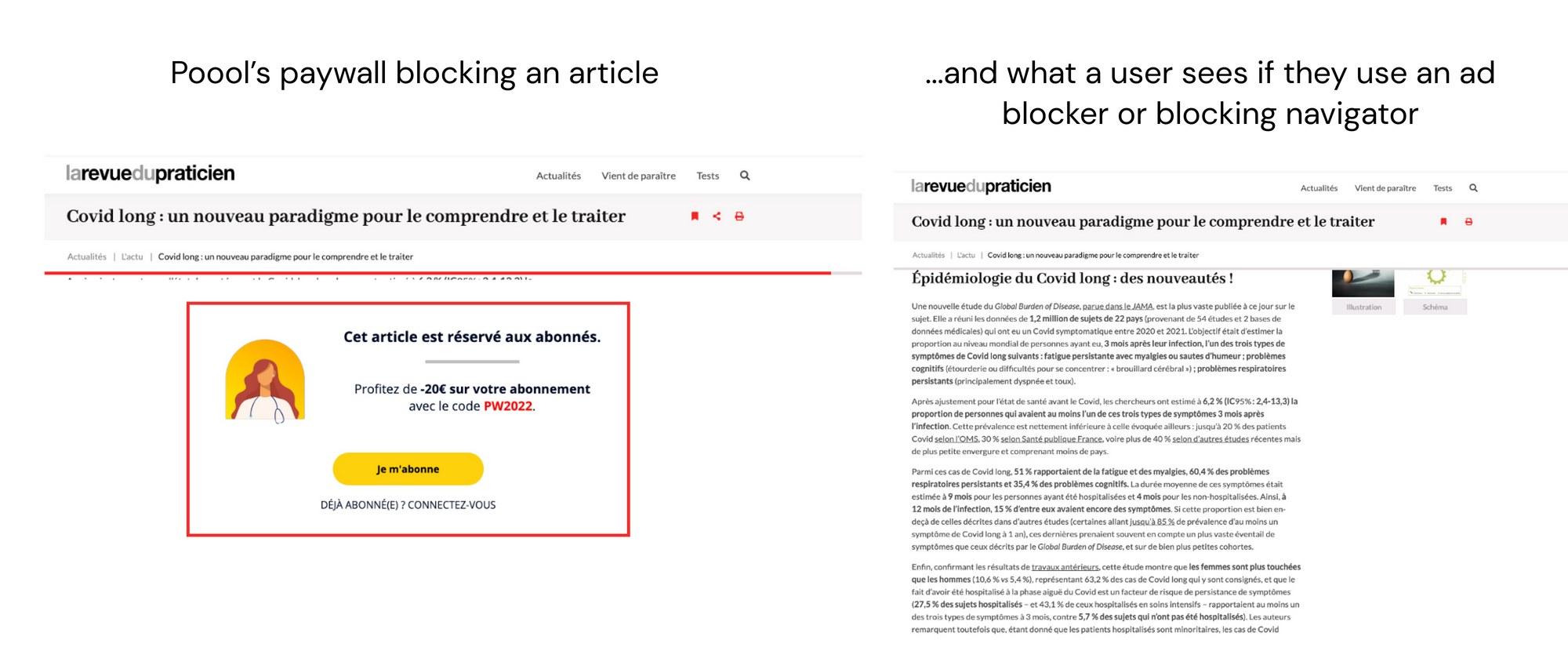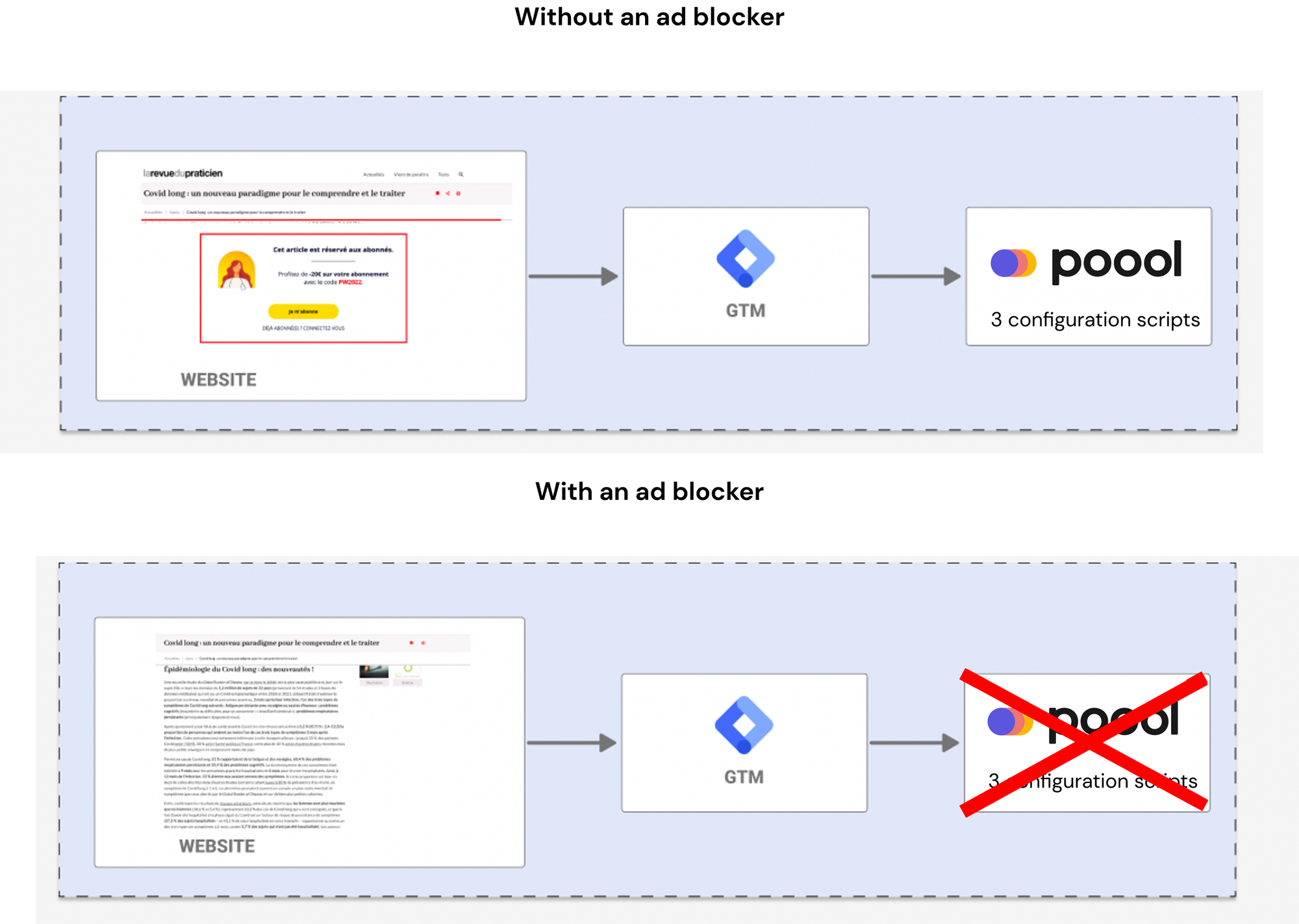This article has been translated & edited from an original published in French by UnNest, a consultancy company of Marketing Technologists, helping marketing teams to take control of their data to better reach their business goals. Find the original here.
Ad blockers are increasingly popular amongst digital consumers, offing an ad-free browsing experience and more privacy, among other benefits.
But their impact for publishers and online businesses is widely misunderstood, or not even known at all. Whilst these tools effectively block certain advertising scripts from being triggered, they can also have a much greater impact on a site’s revenue - including their ability to measure visitor numbers, trigger website features and even limit access to content via a paywall. In short, ad blockers can undermine the two primary digital revenue models for publishers - advertising and subscription.
This article will look at the impact of ad blockers on a publisher’s paywall and subscription strategy, with the example of the French media, La Revue du Praticien. Specifically, how can you continue to block premium content with a paywall when readers are using an ad blocker?
The challenge: guaranteeing that premium content is protected by your paywall despite a reader employing an ad blocker
First things first, how do ad blockers work and what are their practical impact on site tracking?
As a general definition, ad blockers are an anti-advertising software, often in the form of a browser extension, that can suppress the display of advertising and limit tracking. They do this by limiting the number of scripts that can be triggered on a website. For publishers, this means they can’t collect the quality data needed to measure site traffic (Analytics/GTM)... or protect premium content.
However, the various ad blocking solutions available operate to different levels of severity:
👉 The most "tolerant" ad blockers simply prevent ads from being displayed, and even then, not all ads...
In their default configuration, they will:
- Block ads from being displayed
- Likely block ad tracking scripts from being sent (facebook pixel, google ads, floodlight, etc...)
- But they won't block tools that measure visits, content performance etc. (Google Tag Manager, Google Analytics, etc.).
👉 Others will also block tracking scripts, such as Google analytics. This is also the case if someone using the “most tolerant” ad blockers choses to tick the "Do not track " option.
👉 Whilst the most severe, such as Ghostery or Brave Strict, will block everything, including Google Tag Manager scripts.
Importantly, it’s not just a few digital users who activate ad blockers. Globally, 42.7% of internet users have been found to use an ad blocker. And this figure is consistently growing.
These ad blockers, particularly the most stringent ones, have a direct impact on data collection for publishers:
- Ad blockers block analytics script → The amount of traffic on-site is underestimated
- Ad blockers block advertising scripts → under-performing ad displays & so reduced ad revenue
- Ad blockers can block paywall scripts, thus allowing readers to bypass the paywall → premium content is open to non-subscribers, meaning users aren’t being convinced to subscribe & reader revenue is at risk
However, there is a way to solve this final challenge, one that we’ll explain with the example of the French publisher, La Revue du Praticien.

Case study - Poool paywall x La Revue Du Praticien
Digital publishers often have 2 primary revenue streams:
- Online advertising
- Subscriptions
For the latter, there are two access points: the dedicated subscription button, often in the page header, or the paywall, which is most often the main source of subscriptions as it balances frustration and engagement, catching the reader’s interest in the article before blocking access and asking them to subscribe.
This is where Poool comes in. By integrating a script on the publisher’s site, our solution enables marketing teams to fully customize the paywall offer, segment audiences, run tests and configure when the wall is displayed as well as other trigger conditions.
La Revue du Praticien, who use Poool’s solution, is a medical education website for healthcare professionals. Specialized content is reserved for subscribers only (general practitioners, specialists, students, nurses and other healthcare professionals), and access to the rest of the site requires a account creation.
Because of this reader revenue focus, triggering the registration and paywall is essential for La Revue du Praticien’s business. These walls guarantee that content is protected and reserved for members or subscribers only.
However, as discussed above, the use of ad blockers could allow non-subscribers to bypass the paywall and consume premium content by blocking the Poool script, a script that was initially integrated via GTM web.

By using an ad blocker, anyone who is not a subscriber can access premium/paid content, undermining the site's reader revenue model.

UnNest carried out an initial study to take stock of how tools are blocked in different environments, focusing on the most restrictive ones.
In the majority of cases, Poool’s tool is blocked because GTM (Google Tag Manager) is also blocked. Note the case of uBlock Origin, which is more restrictive on Poool than on GTM.

The solution: proxyfying GTM & Poool
To address this issue, UnNest worked with Addingwell, a pioneering server-side tracking agency offering a complete and innovative server-side tagging solution for hosting Google Tag Manager Server Side.
They identified the server-side solution as an area for improvement, as it offers a number of benefits:
- Improved web performance: shifting scripts to the server side improves the speed of page loading on the website
- Fortification of cookie lifespan
- Increased protection and security of personal data
- Optimized data collection by hosting the necessary scripts, such as Google Tag Manager or Poool, with first-party hosting.

GTM's first-party migration
💡 GTM's first-party migration prevents the script from being blocked by third-party tools, loading it on the server side rather than on the client browser
There are 3 options to implement the GTM script on a site. La Revue du Praticien worked through each, with 1 being the least effective against ad blockers, and 3 the best.
1. Classic hosting
This was the original hosting method used by La Revue du Praticien, one where the script was hosted on googletagmanager.com.
In this configuration, many ad blockers can block GTM and therefore the scripts contained therein, such as Poool.
<!-- Google Tag Manager -->
<script>(function(w,d,s,l,i){w[l]=w[l]||[];w[l].push({'gtm.start':
new Date().getTime(),event:'gtm.js'});var f=d.getElementsByTagName(s)[0],
j=d.createElement(s),dl=l!='dataLayer'?'&l='+l:'';j.async=true;j.src=
'https://www.googletagmanager.com/gtm.js?id='+i+dl;f.parentNode.insertBefore(j,f);
})(window,document,'script','dataLayer','GTM-XXXXX');</script>
<!-- End Google Tag Manager -->2. First party hosting
In this case, the Google Tag Manager script is hosted by the publisher’s own servers via a sub-domain, therefore making them first party.
To put this hosting method into practice, La Revue du Praticien worked with Addingwell to create and configure a dedicated sub-domaine, ‘stats.larevuedupraticien.fr’, allowing them to host GTM on the server side.
Here, we used the Content Delivery Network (CDN) function provided by Addingwell to natively proxify GTM and other JS assets. In this way, GTM is integrated as a first-party and wont be blocked by 3rd-party tools.

In this configuration, a few ad blockers still manage to block GTM as well as other scripts on a publisher’s content, such as Poool.
<!-- Google Tag Manager -->
<script>(function(w,d,s,l,i){w[l]=w[l]||[];w[l].push({'gtm.start':
new Date().getTime(),event:'gtm.js'});var f=d.getElementsByTagName(s)[0],
j=d.createElement(s),dl=l!='dataLayer'?'&l='+l:'';j.async=true;j.src=
'https://stats.larevuedupraticien.fr/gtm.js?id='+i+dl;f.parentNode.insertBefore(j,f);
})(window,document,'script','dataLayer','GTM-XXXXX');</script>
<!-- End Google Tag Manager -->3. First party hosting and script modifications
This final method, that we’ve now put in place with La Revue du Praticien to optimize the triggering of Poool scripts, uses the same first party hosting as before but also involves a modification to the js file name, as suggested by Addingwell.
Specifically, the script name is changed from gtm.js to a personalized name. After tests with a wide variety of ad blockers, nothing was able to block the GTM (and so Poool) script.
<!-- Google Tag Manager -->
<script>(function(w,d,s,l,i){w[l]=w[l]||[];w[l].push({'gtm.start':
new Date().getTime(),event:'gtm.js'});var f=d.getElementsByTagName(s)[0],
j=d.createElement(s),dl=l!='dataLayer'?'&l='+l:'';j.async=true;j.src=
'https://stats.larevuedupraticien.fr/byp3nds236zcjhu.js?id='+i+dl;f.parentNode.insertBefore(j,f);
})(window,document,'script','dataLayer','GTM-XXXXXXX');</script>
<!-- End Google Tag Manager -->2. Migrating Poool's script to the server side
In order to avoid the blocking identified on uBlock Origin and, at the same time, improve site loading speed by reducing the number of scripts loaded on the user's browser, Poool’s scripts have been proxyfied in GTM server side.
This reduces the number of scripts loaded on the browser side - in the same way as for GTM, implementing this main script on the server side means the script is hosted in a first-party environment and its triggering is optimized, even in the presence of a severe ad blocker.
Migrating the 6 scripts was made possible by the same Addingwell CDN feature:

Measuring the results
By implementing Google Tag Manager via an upload from a first-party server, Poool’s paywall can be triggered in an optimized manner that better protects premium content produced by La Revue du Praticien’s teams.
Tech results
To measure the result, we triggered the various tools on each of the different environments, comparing performance before and after proxification. We note that in 100% of cases, the tools are no longer blocked, making Poool’s implementation more robust and consistent.
Initial findings:

Findings after proxifying the two tools:

To confirm and quantify this finding, we followed Simo Ahava's method for detecting ad blockers with GTM Server Side (link to method), which involves testing the blocking of advertising scripts, analytics and Google Tag Manager. Using this method, we estimated that ad blockers were being used on La Revue du Praticien’s premium article pages 10% of the time over the period from 9 March to 20 April.

In this study, we didn’t measure the webperf impact of reducing the number of scripts and libraries loaded on the user's browser via the proxyfication of GTM and Poool.
Business results
While it’s difficult to measure the exact impact of this strategy on the publisher’s revenue due to the variety of factors that go into their performance, we have measured several positive signals indicating a positive impact our use case.
Since putting these optimization strategies in place, we measured an increase in page views of around 10% and a similar increase in the number of paywall impressions without any specific actions being taken over this same period. Similarly, click-through-rate to subscription and the number of free accounts created increased by 9%.
This proportional gain in volume also seems to correspond to the average percentage of readers using ad blockers over the same period.
In conclusion
This use case demonstrates once again the immensity of the applications of Google Tag Manager's Server Side technology and its relevance to one of the (many) advantages of an advanced Server Side implementation. Specifically, improved data collection.
In this way, La Revue du Praticien's content team ensures that premium content is properly protected with Poool’s tool. At UnNest, we're big believers in this technology and are working on other use cases, including privacy and RGPD compliance with our GA4 proxyfication method, and advertising tracking with Facebook CAPI. Don't hesitate to contact our teams to help you with your data strategy and your Server Side migration project!
UnNest is a consultancy company made up of 25 experts in Data Marketing, covering everything from tracking, data engineering, Dashboard design, CRM & marketing automation. In short, they're Marketing Technologists, helping marketing teams to take control of their data to achieve that goals, and more. Find them on LinkedIn or contact them at contact@unnest.co
Poool is The Membership & Subscription Suite, a simple, all-in-one solution for digital publishers to better convert, manage and retain their members and subscribers.
Book a demo for a no-obligations consultancy session with our team to launch or optimize your reader revenue model.
Book a demo
